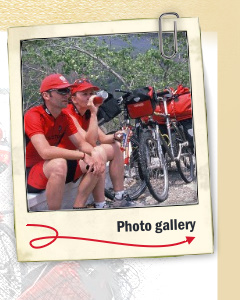San Cristobal and its surroundings
Having reached San Cristobal de las Casas, we had to put on fleece jackets and long trousers. The temperature fell to ca. 25 degrees, while we had got used to 40 degrees and more – we were simply cold. San Cristobal was a typical, quiet Mexican town. Cobbled streets, modest but colourfully painted cottages and town houses. As was the case with other towns, the market square was the most important place. In the evening we could listen to a band playing live music, dance salsa, and have a drink. Moreover, this was where we tasted the best cake in the world! Nowhere else, never before and never again had we enjoyed a cake the same way as in San Cristobal. A nearby market place was a tourist paradise. Jewellery, belts, hats, sweatshirts, shawls, tablecloths, sculptures, masks, … and everything was so cheap! Besides, we could always haggle!
But it was tourists' paradise only. The traders often slept on pavements while looking after their goods. Each of them hoped that a tourist would come and buy something. The prices were much lower than those in Cancun – obviously incommensurate to the effort those poor people made to complete their work. In Mexico nobody waited for an allowance, nobody complained that it was not worth working. People would gather with their friends under a tree, and encourage tourists to dance to the rhythm of salsa and throw a few pesos into their hats by the way. This is why on many occasions we bought more than we needed, usually from the poorest looking elderly ladies, and without haggling – we just felt it would be wrong.
In San Cristobal de las Casas there were a few travel agencies offering trips to villages of indigenous tribes.
San Juan Chamula – I was impressed by a cemetery full of crosses in different colours. White crosses indicated graves of children and young people, blue – those of middle aged persons, and black – tombs of elderly people. The number of crosses next to each grave showed how many children the buried person had. Tombs made of concrete belonged to wealthy citizens. Then the church – amazing – its floor lined with dry grass, with human-sized statues of Saints standing by the walls. There was no altar. There were no priests. The church was looked after by the faithful. People would simply go there to pray. Sometimes a Shaman prayed on their behalf, using candles, incense sticks, and offering chicken or a bottle of Coca Cola! (When he burped during such prayer, bad spirits were chased away). For us it was shocking, but this is the way it works over there. No-photo policy, of course. Tour guides knew exactly where they were allowed to go with "strangers". We met indigenous women weaving fabrics, but unfortunately the capacity of our bikes and panniers was limited.
That day we also tasted some night life, starting with a delicious drink in the main square. Then we had dinner in one of numerous restaurants, and there it began: food, drinks, and salsa with a live music band! These are the moments we save in our hearts for a rainy day.
But it was tourists' paradise only. The traders often slept on pavements while looking after their goods. Each of them hoped that a tourist would come and buy something. The prices were much lower than those in Cancun – obviously incommensurate to the effort those poor people made to complete their work. In Mexico nobody waited for an allowance, nobody complained that it was not worth working. People would gather with their friends under a tree, and encourage tourists to dance to the rhythm of salsa and throw a few pesos into their hats by the way. This is why on many occasions we bought more than we needed, usually from the poorest looking elderly ladies, and without haggling – we just felt it would be wrong.
In San Cristobal de las Casas there were a few travel agencies offering trips to villages of indigenous tribes.
San Juan Chamula – I was impressed by a cemetery full of crosses in different colours. White crosses indicated graves of children and young people, blue – those of middle aged persons, and black – tombs of elderly people. The number of crosses next to each grave showed how many children the buried person had. Tombs made of concrete belonged to wealthy citizens. Then the church – amazing – its floor lined with dry grass, with human-sized statues of Saints standing by the walls. There was no altar. There were no priests. The church was looked after by the faithful. People would simply go there to pray. Sometimes a Shaman prayed on their behalf, using candles, incense sticks, and offering chicken or a bottle of Coca Cola! (When he burped during such prayer, bad spirits were chased away). For us it was shocking, but this is the way it works over there. No-photo policy, of course. Tour guides knew exactly where they were allowed to go with "strangers". We met indigenous women weaving fabrics, but unfortunately the capacity of our bikes and panniers was limited.
That day we also tasted some night life, starting with a delicious drink in the main square. Then we had dinner in one of numerous restaurants, and there it began: food, drinks, and salsa with a live music band! These are the moments we save in our hearts for a rainy day.




